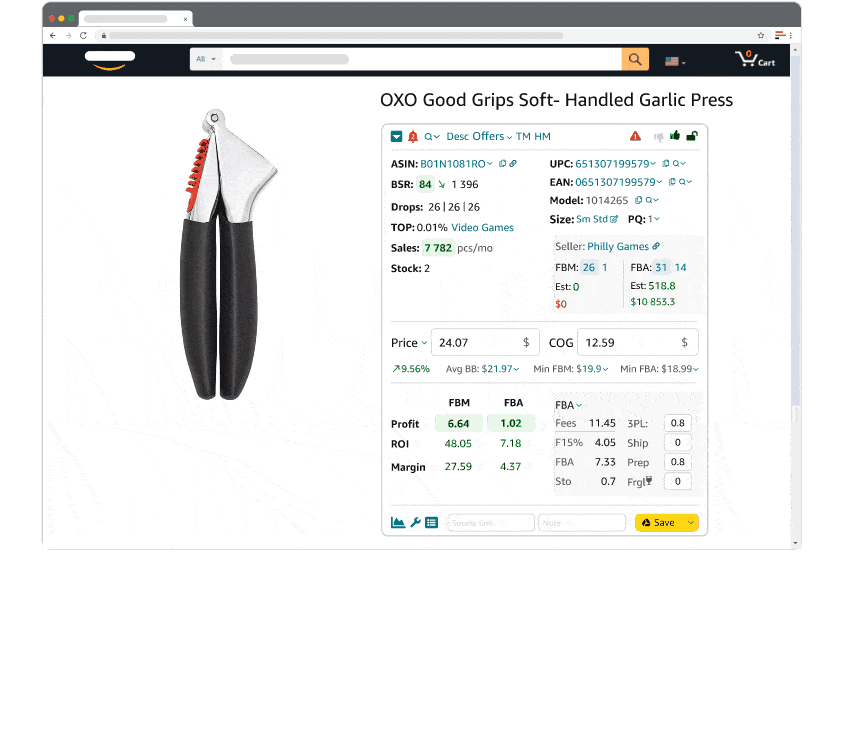Aloha, Amazon Seller!
The first thing we must say is that there is no all-in-one pricing strategy for all occasions. If you are looking for a simple solution, you will be, most likely, disappointed. However, you can use various combinations of FBA pricing strategies and tips for each of your products, the same way as you do when you create your brand listing.
There are, of course, ‘seller gurus’, saying that ‘from their experience’, you can simply add on a more-or-less 5% (1.5%, 3%...) to the average Amazon price and this is it. If you do that, most likely your product will appear on page 18 of the organic search and no one would even consider buying it.
Okay, how to avoid that and how to price on Amazon? As always, you need to be analytical, and, as strange as it sounds with regard to pricing, you need to be creative. But first of all, you have to understand that pricing strategy as such is a part of your product concept. Moreover, item pricing is an essential driver of your overall marketing strategy for the product, and, if applied wisely, can become an added value to attract conversions.
That said, you must admit from the start that there is some way to go in order to set your perfect price. But at the far end, your efforts will be rewarded. Firstly, you will get your money, which is the goal of each sale. And secondly, you will find out that the process of setting an Amazon pricing strategy is very similar to the quest: it’s very exciting to go through the labyrinth of figure-driven product metrics.
Why Price Matters?
It is as simple as that. If you overprice your product, shoppers will go and buy from your competitors. If you underprice, chances are that you run into two very unpleasant consequences. The first one is that you don’t get back the money you invested because your expenses are not covered. The second one is that you might initiate a price war with the competitors, which is a rather expensive and dangerous thing unless it is a strategy in itself aimed at destroying the competition.
The conclusion is, therefore, that the price level should be appropriate. And how to know that? How to price a product? See below.
Pricing Items as a Part of the Product Amazon Pricing Strategy
The best price is the one matching customer value. Therefore, private label products, for instance, are never priced too low. When you’ve outlined your Amazon FBA strategy, you should have already decided what is the customer value of your product. This means that you’ve determined the market niche and your product's Unique Selling Points. This is the first step.
In practice, this would mean, that if you trade regular products and you aim at selling a lot of them, therefore counting at selling fast and big quantities, you should not price your product too high, or, rather, count on a very high margin. And, on the contrary, if you sell a unique or branded item, you can price it high, but you are normally not selling huge amounts of those.
When, according to your Amazon FBA strategy, you price your product high, you communicate a message to the buyers, that your product is very special. If you are not able to justify this to the shopper – they will not pay the price. But if you do, brand awareness and good reviews are likely to drive conversions.
Marketing Pricing Strategies
There are numerous pricing approaches to introduce the product to the market. These are, for instance:
Premium Pricing – is used for luxury, prestige, or exclusive products;
Competition-Based Pricing - grounds on existing prices;
Cost-Plus Pricing – fixed % is added on top of COGS (cost of goods);
Dynamic Pricing – variable price based on customer demand;
Skimming Pricing – setting a high price when product is new and lower gradually as it loses in novelty;
Penetration Pricing – selling at a low price and increasing it as product gains popularity, should be applied short-term only;
Value-Based Pricing - pricing is based on how much the customer believes a product is worth.
It is good to consider one or a couple of these approaches when you perform Amazon pricing strategy analysis. This gives you a picture as to how you introduce your product to the market and create your Amazon seller strategy.
But this is not the end of it.

Breakeven and Profit Margin
The price should account for all cost price components to cover your expenses. Plus, you should be able to squeeze in some margin.
Breakeven
This is very important. Breakeven is a ‘floor price’: you cannot go lower (unless you do it intentionally), because you will lose money. Normally it is said that it’s very difficult to account for all business analytics metrics. You know that Amazon charges you 80+ different fees, you have your PPC campaign costs, there are a lot of other expenses burning your profit. SelleRise, a seller profit analytics tool, makes this process easy and visual.
Profit Margin
Profit Margin shows a percentage of sales that has turned into profits. There is a formula to calculate it.
Profit Margin = ((Sales – Total Expenses) ÷ Revenue) x 100
If you don’t want to bother with figures too much, we would simply recommend that you aim at an average of 20-30% of your profit margin.
Tip. To quickly and effectively source profitable products with high-profit margins, merchants use product research tools. Seller Assistant Аpp is one such tool that can reliably help you with this task. This all-in-one extension incorporates all features vital for product research. Seller Assistant App shows you the product’s profit, margin, and ROI. It also helps you immediately see if a product has any sales restrictions or has triggered problems with account health in the past. It combines an FBM&FBA profit calculator, Quick View, Stock Checker, and Restrictions Checker in one tool.

Competitive Pricing
Once you’ve determined what your target price should be, you would need to understand if it is competitive and how it matches the existing market price levels. In other words, you need to see how similar products are priced and adjust your price accordingly depending on your pricing strategy.
Set a ‘Price Corridor’
When you look into the prices competitors set out, it’s a good idea to determine the extremes: the lowest and the highest pricing. If you are not selling the branded or unique items, which are normally priced higher, outlining minimum and the maximum market price will help you position your product according to your strategy. For instance, if you think that your product is new to the market and you aim at a skimming model, then it’s a good idea to set your price a bit higher than average.
A/B Test Different Prices
Now it’s time to test in practice the price you figured out in theory. A good way to do so is the A/B pricing test, otherwise also called a split test. This is how you find out if your price is competitive and prove that you’ve calculated everything the right way.
Doing an A/B pricing test means that you list your item at two price levels and let them sit there for some time. Afterward, you analyze the key metrics and pick the most successful one.
Analyze Competitors’ Pricing Models
When setting your product prices, it is very useful to monitor the competitor's pricing history. You can see how it changes over time and understand the tendencies. This will give you tips on what worked out and what didn’t. Also, you can use reviews of competitor’s items as a source of information. Especially this is true with negative reviews: you will definitely know what you shouldn’t do.
Dynamic vs. Static Pricing
There are a lot of FBA pricing strategies based on dynamic pricing. This means that you apply variable prices based on the market demand or gradually raise or lower the price with time. This approach gives a positive result when it’s a part of your strategy, like in the case of penetration pricing, or when you have high competition in your niche and a lot of new products pop up. Then you need to often adjust the prices.
However, when it comes to private label products, there is an opinion that stable pricing builds up the positive reputation of a brand. The proponents of this pricing strategy say, that if you keep the prices on the same level, this meets customer’s expectations and increases trust in the brand from the regular shoppers.
Whatever your strategy is, it’s a good idea to review your prices on a regular basis and analyze what inventory needs to be repriced.
Account for the ‘Human Factor’
There is a separate strategy called ‘psychological pricing’. In the case of Amazon products, we would rather recommend considering consumer behavior as the component influencing price strategy. Of course, not all buyers are applying logical approaches when making buying decisions. However, when it comes to Amazon shoppers, research justifies, that around two-thirds of them are ‘methodical’ buyers, and only one-third is qualified as ‘spontaneous’.
This, of course, doesn’t mean that you should skip just-below prices like $29.99. This is a good tool to attract customers. The buyer anticipates the offer as somehow discounted, while the theory of psychological pricing itself stipulates that the buyer rounds to the next lowest price figure. Psychological pricing should be taken into account when pricing branded products as well. The premium items should have a ‘no-cent’ price, like $25.00.

Tips for Your Pricing Strategies
When you determined the price level for your item, you can still use some techniques to stay on top of your competitors.
Apply Discounts
On Amazon, you have several options to offer discounted prices. You can choose to offer coupons. Surprisingly, as many as half of your potential buyers will click on coupons. Just keep in mind that Amazon charges 60 cents for each coupon. You can also use promotions or sales pricing. You can add discounts to a listing in your Amazon Seller Central under ‘Advertising.’
Convince People to Buy Your Product
You should always show people why your product is better. Make it visible. Think about free shipment and other options and include them on the listing. The ideas you can find in the reviews of the products of your competitors.
Make Offers to Business Customers
It’s a good idea to register as a business seller in your Seller Central. Business Customers can buy big numbers of products, and if they do, offer then special price.
Put a Price Higher than Amazon’s Free Shipping Level
Non-Prime members on Amazon in the US have to pay for shipping on all purchases below $25. Price your product higher to allow shoppers for free delivery.
Think about Repricing
Analyze your inventory and outline what needs to be repriced first. Declare sales on the ‘sitters’ and set discounts.
Alongside with this, don’t forget to control your product performance figures. You can get your Amazon analytics easily with SelleRise.







